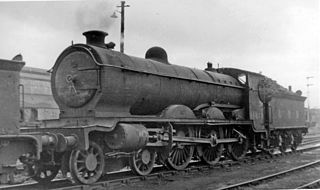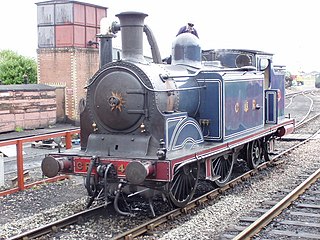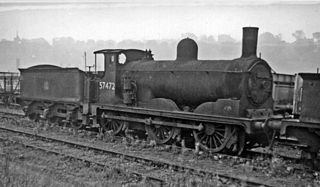Related Research Articles

The London, Midland and Scottish Railway (LMS) Coronation Class is a class of express passenger steam locomotives designed by William Stanier. They were an enlarged and improved version of his previous design, the LMS Princess Royal Class, and on test were the most powerful steam locomotives ever used in Britain at 2,511 dbhp. The locomotives were specifically designed for power as it was intended to use them on express services between London Euston and Glasgow Central; their duties were to include the hauling of a proposed non-stop express, subsequently named the Coronation Scot. The first ten locomotives of the Coronation class were built in a streamlined form in 1937 by the addition of a steel streamlined casing. Five of these ten were specifically set aside to pull the Coronation Scot. Although a later batch of five unstreamlined locomotives was produced in 1938, most of the ensuing Coronation class were outshopped as streamliners. From 1944 until production ended in 1948, all-new engines were built in unstreamlined form and all the streamliners had their casings removed. The last of the 38 locomotives was completed in 1948.

The steam locomotives of British Railways were used by British Railways over the period 1948–1968. The vast majority of these were inherited from its four constituent companies, the "Big Four".

The Caledonian Railway 812 and 652 Classes were 0-6-0 steam tender locomotives designed by John F. McIntosh for the Caledonian Railway and introduced in 1899. They had the same boiler type as the 721 “Dunalastair” Class 4-4-0s. They could reach speeds of up to 55 mph.

The Caledonian Railway 60 Class were 4-6-0 passenger engines designed by William Pickersgill and introduced in 1916. Six were built by the Caledonian Railway at its own St. Rollox works in 1916–17, and all of them passed into LMS ownership in 1923. A further twenty locomotives of a slightly modified design were built by the LMS under the auspices of George Hughes in the period of 1925–1926.
The Caledonian Railway 956 Class were 3-cylinder 4-6-0 steam locomotives that were used on the Caledonian Railway from 1921. They were built to the design of William Pickersgill. At the time they were the largest design operated by a Scottish railway.

The Caledonian Railway 439 Class is a class of 0-4-4T steam locomotive. It was a development of earlier Caledonian Railway 0-4-4T locomotives, including the 19 Class and 92 Class, and predecessor of the 431 Class. The 439 Class was introduced by John F. McIntosh in 1900 and a modified version was introduced by William Pickersgill in 1915.

The Caledonian Railway 498 Class was a class of 0-6-0Ts built for dock shunting. They were designed by John F. McIntosh for the Caledonian Railway (CR) and introduced in 1911. Twenty-three were built. They passed to the London, Midland and Scottish Railway (LMS) in 1923 and to British Railways (BR) in 1948. Their numbers are shown in the table below.
The Glasgow and South Western Railway (G&SWR) 403 Class was a class of 2-6-0 (mogul) steam locomotive designed by Peter Drummond, of which 11 were built in 1915 by the North British Locomotive Company at its Queens Park works. Originally built as the 403 class, as a result of renumbering they became known as the 33 Class in 1916 and then 51 Class in 1919, before passing to the London Midland and Scottish Railway (LMS) on its formation in 1923, where they were given power classification 4F.

The Caledonian Railway 782 Class was a class of 0-6-0T steam locomotives designed by John F. McIntosh and introduced in 1896. The 29 Class was similar but fitted with condensing apparatus. The locomotives were taken into London, Midland and Scottish Railway (LMS) ownership in 1923 and into British Railways (BR) ownership in 1948.

The Caledonian Railway 264 and 611 classes were 0-4-0 saddle tank locomotives designed by Dugald Drummond and built by Neilson and Company in 1885. Later examples were built at St Rollox Works under the direction of John F. McIntosh in 1895, 1900, 1902 and 1908.

The Caledonian Railway 721 Class was a class of 4-4-0 steam locomotives designed by John F. McIntosh for the Caledonian Railway (CR) and introduced in 1896. All survived to be absorbed by the London, Midland and Scottish Railway (LMS) in 1923 and a few survived into British Railways (BR) ownership in 1948.

The Caledonian Railway 294 and 711 Classes were 0-6-0 steam locomotives designed by Dugald Drummond for the Caledonian Railway (CR) and introduced in 1883. After Drummond's retirement, construction of the class continued under Smellie, Lambie and McIntosh.

The G&SWR 5 Class were 0-6-0T steam locomotives designed by Peter Drummond for the Glasgow and South Western Railway (G&SWR) and introduced in 1917. The class was originally designated 5 Class but, after the G&SWR's 1919 renumbering, this was changed to 322 Class. After passing to the London, Midland and Scottish Railway (LMS) in 1923 they were given power classification 2F.
The Caledonian Railway 191 Class were 4-6-0 passenger engines designed by William Pickersgill and built in 1922 by the North British Locomotive Company. The class was intended for use on the Callander and Oban line, to augment the 55 Class 4-6-0s and replace elderly 179 Class 4-4-0s, and they were thus known as the New Oban Bogies, however, they were also used on other Caledonian lines.

The Caledonian Railway 49 Class and 903 Class were 4-6-0 express passenger locomotives designed by John F. McIntosh and built at the Caledonian Railway's own St. Rollox Works in 1903 and 1906 respectively.
The Caledonian Railway 55 Class were 4-6-0 mixed-traffic locomotives designed by John F. McIntosh and built at the railway’s St. Rollox works in Glasgow in 1902-1905. The class was intended for use on the Callander and Oban line and were sometimes known as Oban Bogies, a nickname they shared with the earlier Brittain 179 Class 4-4-0s and the subsequent Pickersgill 191 Class 4-6-0s, all of which were built for use on the same route.
The Caledonian Railway 908 Class were 4-6-0 mixed traffic locomotives designed by John F. McIntosh and built in 1906, at the Caledonian Railway's own St. Rollox Works.
The Caledonian Railway 918 Class were 4-6-0 steam tender locomotives designed by John F. McIntosh and built in 1906, at the Caledonian Railway's own St. Rollox Works.
The Glasgow and South Western Railway 540 Class were 4-6-4T steam tank locomotives designed by Robert Whitelegg and built in 1922, shortly before the G&SWR was absorbed into the London, Midland and Scottish Railway (LMS). They were referred to in official G&SWR publicity as the Baltic Class, although they were also known more prosaically to enginemen as the 'Big Pugs'.
The Caledonian Railway 944 Class were 4-6-2T passenger tank locomotives designed by William Pickersgill and built in 1917, at the North British Locomotive Company's Hyde Park Works in Glasgow. They were the Caledonian Railway's only pacific-type.
References
- 1 2 3 4 5 6 Atkins, C. P. (1976), The Scottish 4-6-0 Classes, Ian Allan, p.105
- ↑ Atkins, C. P. (1976), The Scottish 4-6-0 Classes, Ian Allan, p.43
- ↑ Essery, Bob & Jenkinson, David (1986), An Illustrated History of L.M.S. Locomotives, Volume Three: Absorbed Pre-Group Classes, Northern Division, OPC, p.104
- ↑ Atkins, C. P. (1976), The Scottish 4-6-0 Classes, Ian Allan, p.48
- ↑ "BritishSteam locomotive information". BritishSteam.com. Archived from the original on 4 April 2013. Retrieved 26 May 2013.